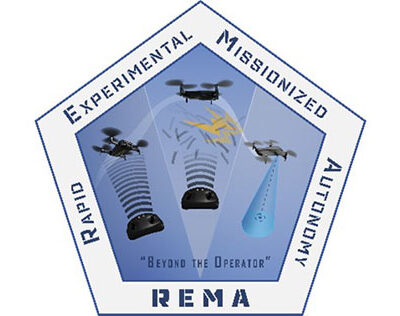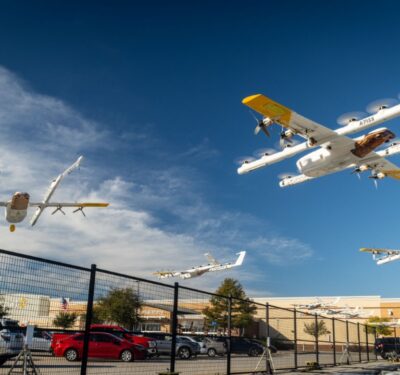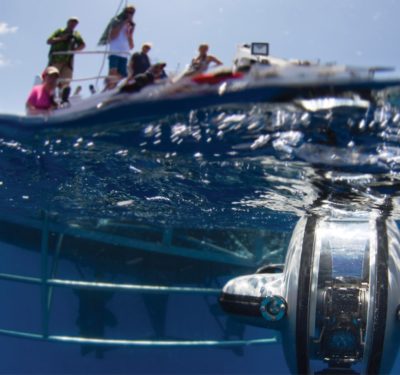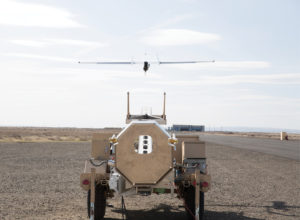
The new ScanEagle3 takes off during a test.
July is always a big month in aviation because the Paris Air Show and Farnborough alternate each year in July. It was Farnborough’s turn this year. Normally, the big news from the show is something to do with manned aircraft—a huge airliner sale, a new fighter design or a breakthrough in avionics. There was a lot of competition for top news at Farnborough this year—the Brits announced a new stealth fighter design (The “Tempest”), Richard Branson announced he’ll take his kids on his first space tourist flight and Boeing announced more than $100 billion in aircraft orders.
“THE BIGS” STEP UP
However, I think the biggest news this year is that “The Bigs” finally stepped into the commercial market for large unmanned aircraft systems (UAS) in a big way. General Atomics flew its “civil certifiable” MQ-9B SkyGuardian across the Atlantic from Grand Forks Air Force Base in North Dakota to Royal Air Force Fairford in the UK in a 24-hour mission and was the first UAS to operate in British airspace controlled via satellite communications. It landed with 16 hours of fuel remaining. Elbit Systems announced its civil certifiable Hermes 900 StarLiner that is fully compliant with NATO’s Standardization Agreement (STANAG) 4671, qualifying it to be safely integrated into civilian airspace. The biggest of The Bigs, Boeing/Insitu, got ahead of GA and Elbit at AUVSI’s Xponential in May by announcing their ScanEagle3 civil certifiable UAS. What prompted this madness? What on earth does “civil certifiable” mean? Who comes up with these names???
WHY NOW?
The method behind all this madness is a decision by The Bigs that the major global civil aviation authorities are finally serious about approving large UAS commercial flight in controlled airspace. The U.S. Federal Aviation Administration (FAA) convened a UAS in Controlled Airspace Aviation Rulemaking Committee (ARC) last fall, the British Civil Aviation Authority approved the methodology for beyond line of sight (BLOS) operation for the MQ-9 flight to RAF Fairford, and the Civil Aviation Authority of Israel is putting the Hermes 900 through the paces for eventual type certification. These advancements, combined with a whole host of nearly ready BLOS standards from standards bodies ASTM and RTCA, apparently convinced these Bigs to pull the trigger on serious commercial grade large UAS platforms.
Why did all three take pains to claim they were “civil certifiable?” Why mention it at all if there aren’t rules for UAS type certification? I think it’s their way of saying they’re confident the UAS will pass UAS type certification rules when they come out. Even more importantly, it’s an expression of their confidence that there will be UAS type certification rules to pass. Having a large aerospace company commit to passing type certification for a production aircraft means a large resource commitment. When I was on the Air Staff I spent more than $50 million to have General Atomics’ MQ-9/Reaper pass Air Force airworthiness standards and civilian standards are much more exacting—and expensive. What’s more, commitment to a civil certifiable UAS means these companies think there is enough of a commercial UAS market to manufacture aircraft that may need expensive modifications when final airworthiness standards come out. That’s a serious investment showing a serious commitment to the commercial market by three large aerospace companies that have been hesitant about commercial UAS in the past.
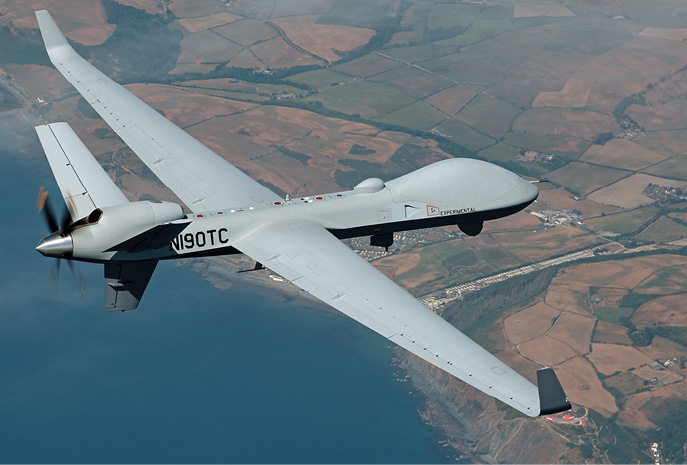
General Atomics MQ-9B flew from Grand Forks, North Dakota to the Farnborough Airshow with 16 hours of fuel to spare.
STRATEGIC CHOICES
The General Atomics and Elbit airframe choices represent the traditional approach to UAS BLOS operations. These are large aircraft with big payloads and long range. The MQ-9 has a 4,800-pound payload with 40 hours of fuel onboard. The Hermes 900 can carry a 1,000-pound payload for 36 hours. Both are designed to operate from runways at large fixed sites, using their long range, high capacity satellite communication links and large payloads to shuttle out to a job site and stay there for a long time. The U.S. and Israeli Air Forces are masters at this type of BLOS operation. They cut costs by centralizing maintenance and launch/recovery operations at a handful of bases while employing consolidated pools of aircrew to fly the aircraft remotely from thousands of miles away. Instead of having to station aircraft, maintenance crews and pilots within a few hours of their targets as they must do for manned aircraft, American and Israeli drone commanders simply keep more drones in transit to cover distant targets for weeks. Keeping an F-16 constantly over a target three hours from its base would take an entire 24 aircraft squadron with more than 40 pilots. An MQ-9 or Hermes 900 unit could do it with two aircraft and seven pilots. General Atomics or Elbit could probably cover the entire continental United States with three or four bases using this methodology. Flight hour costs with this approach would be low and it might be best to sell drone support by the hour, as drones would probably support several customers during each cycle.
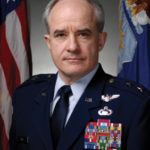
Maj. Gen. James R. Poss designed the U.S. Air Force’s remote split operations system for UAS control, and helped design the Distributed Common Ground Station for UAS intelligence analysis. General Poss was the Executive Director of the Alliance for System Safety of UAS through Research Excellence (ASSURE) of the Federal Aviation Administration’s (FAA) Unmanned Aerial Systems (UAS) Center of Excellence Team. He is CEO of ISR Ideas—an intelligence, unmanned systems and cyber warfare consulting company with decades of intelligence community experience, coupled with insider FAA knowledge.
Boeing took a different approach with the ScanEagle3. Rather than operating from a few centralized bases, ScanEagles can use their innovative Mark IV pneumatic launcher to fly from small fields and recover by snagging a wingtip on a wire held by their SkyHook recovery system. The ScanEagle was originally designed for tuna fishing and can operate easily from even small fishing vessels. A football field-sized operating area would be a luxury for the ScanEagle. This kind of mobility comes at a price and the ScanEagle3 can only carry a 20-pound payload for about 18 hours. Boeing is betting that having crews on the ground near their customers will make all the difference—and they may be correct. Large consolidated bases with drones flying hundreds of miles to their targets work well for Air
Force operations because airmen are used to dealing with aircraft flying from multiple bases and meeting in the air over a target area. These operations were a tough sell to the Army and Marines. They never really trusted aircraft or pilots that weren’t based right next to their ground troops. This approach might work best, especially in the early days of BLOS while customers are still learning how to best employ high altitude large drones.
THE BIGS’ MARKET
But what can drones do from controlled airspace? Although the UAS in Controlled Airspace ARC hasn’t reported out yet, it will probably recommend that drones launch and then spiral up from the surface into Class A airspace using either onboard sense and avoid equipment like General Atomics’ Due Regard Radar or ground based sense and avoid radars like SRC’s LSTAR. Once they reach Class A airspace at 10,000 feet, the drones would fly under instrument flight rules using navigation devices for manned aircraft like ADS-B to maintain safe separation. Class A airspace may sound like it’s too high to collect the kind of high-resolution imagery available to small drones flying under Part 107 rules at below 400 feet, but optics can easily compensate for longer distances. Indeed, most military drone sensors are designed to operate above 10,000 feet to keep the drone out of ground fire range. Although delivering packages door to door from 10,000 feet will never be viable, delivering both short and long-range cargo will eventually be much cheaper using large drones versus manned aircraft. Organ, vaccine and blood transport are other missions that large drones which spiral up and down into Class A airspace can accomplish.
I’m probably missing dozens of new missions from my list, but that’s not the important development here—the important thing is that large, experienced aerospace companies have decided it’s safe to make commercial drones because they are confident we are on the verge of enabling rules from the FAA and other world aviation authorities. The Bigs may not always move fast, but they do move carefully. And these careful companies now think it’s time to move fast!
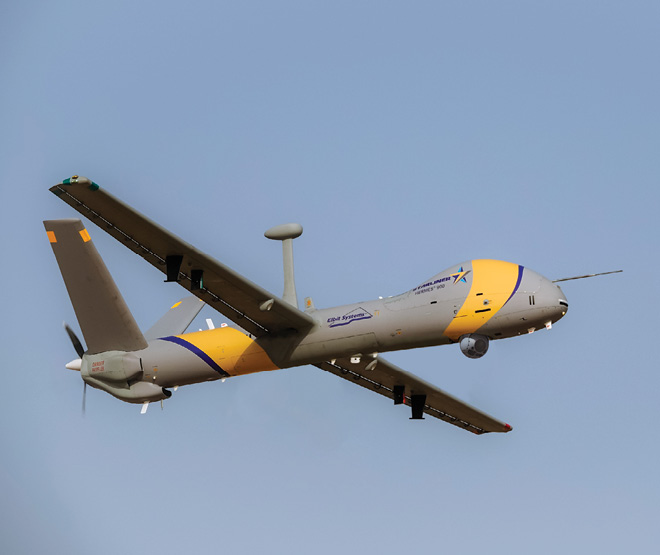
The Hermes 900 StarLiner
was introduced at Farborourgh by
Elbit Systems.


